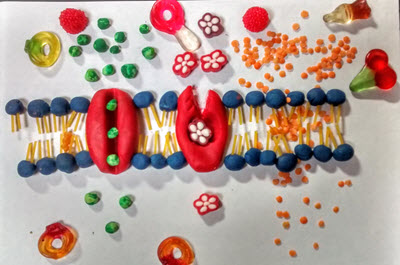Crafting and baking in IB Biology
Thursday 1 October 2020
 Teachers working to keep students engaged while delivering lesson using computers at a distance are frequently encouraged to think about screen free activities. There are many possible options in IB Biology which could help continue student learning away from the screen. The idea for this post was inspired by a small crochet coronavirus which was sent to me by my sister-in-law Sue during our first covid lockdown.
Teachers working to keep students engaged while delivering lesson using computers at a distance are frequently encouraged to think about screen free activities. There are many possible options in IB Biology which could help continue student learning away from the screen. The idea for this post was inspired by a small crochet coronavirus which was sent to me by my sister-in-law Sue during our first covid lockdown.
While the Virus is cute, virus structure does not feature in the IB Biology guide, but it got me thinking about other ideas for students to make models, get away from screens and learn some useful biology?
Baking cakes was the first idea. The Physiological society in London has been running a #biobakes competition for several years. Why not ask students to bake a biology diagram like these entries to the competition? Four of these cakes in the image below would illustrate part of Human physiology - Topic 6.
.jpg) Another way to build models, even in confinement, is to draw them larger than life on a flat surface, using chalk on a pavement or playground. This model shows students acting out the three neurones of the reflex arc. Using little packets (vesicles) of sweets (neurotransmitters) at each synapse they demonstrate the functioning of synapses. The impulse, carried along the inside of each neurone could be represented by a cuddly toy, or a cardboard and aluminum foil spark. It's great fun, although slightly crazy, and a good way to introduce the components of a reflex arc in Neurones & synapses - Topic 6.5.
Another way to build models, even in confinement, is to draw them larger than life on a flat surface, using chalk on a pavement or playground. This model shows students acting out the three neurones of the reflex arc. Using little packets (vesicles) of sweets (neurotransmitters) at each synapse they demonstrate the functioning of synapses. The impulse, carried along the inside of each neurone could be represented by a cuddly toy, or a cardboard and aluminum foil spark. It's great fun, although slightly crazy, and a good way to introduce the components of a reflex arc in Neurones & synapses - Topic 6.5.
I f space is a problem, then smaller models can be fun too. How about building a model of a nucleosome from nine gummy bear histone proteins, wrapped around with paper tape or licorice laces representing DNA?
f space is a problem, then smaller models can be fun too. How about building a model of a nucleosome from nine gummy bear histone proteins, wrapped around with paper tape or licorice laces representing DNA?
Students could even try building a nucleosome using a mix of flour and water that could be baked into mini-bread buns. A very tasty addition to the HL DNA section of Topic 7
 Simple paper cut-outs can also animate an explanation. It's always easier to talk about something when you are pointing at a model. These actin and myosin models can be made in just a minute using nothing more than a piece of paper and scissors. The might help students to explain details of the sliding filament theory in muscle contractions of HL physiology Topic 11 Eukaryotic Cell Ultrastructure Posting a photo with a few labels could make a useful activity.
Simple paper cut-outs can also animate an explanation. It's always easier to talk about something when you are pointing at a model. These actin and myosin models can be made in just a minute using nothing more than a piece of paper and scissors. The might help students to explain details of the sliding filament theory in muscle contractions of HL physiology Topic 11 Eukaryotic Cell Ultrastructure Posting a photo with a few labels could make a useful activity.
 For something more ambitious, I like to raid the kitchen and use lentils and pasta to explain the different methods of movement across membranes. Membranes are an important part of topic 1 Cells, and they also feature in Topic 6 Human physiology and Topic 9 Plants. There are some resources on this page of the Inthinking site: Membrane transport models.
For something more ambitious, I like to raid the kitchen and use lentils and pasta to explain the different methods of movement across membranes. Membranes are an important part of topic 1 Cells, and they also feature in Topic 6 Human physiology and Topic 9 Plants. There are some resources on this page of the Inthinking site: Membrane transport models.
And lastly for some historical, nature of science learning, useful in Topic 1 Cells, there are some great instructions for building a model of Anton Van Leeuwenhoek's microscope. A very thorough version in card can be found on Instructables DIY cardboard microscope project. There are also options to make the lens from a glass sphere as van Leeuwenhoek did himself on Bizzare labs Leeuwenhoek's microscope, some nice alternatives on Fun science gallery. A good Dutch version Making an Antoni van Leeuwenhoek microscope replica by Hans Loncke



